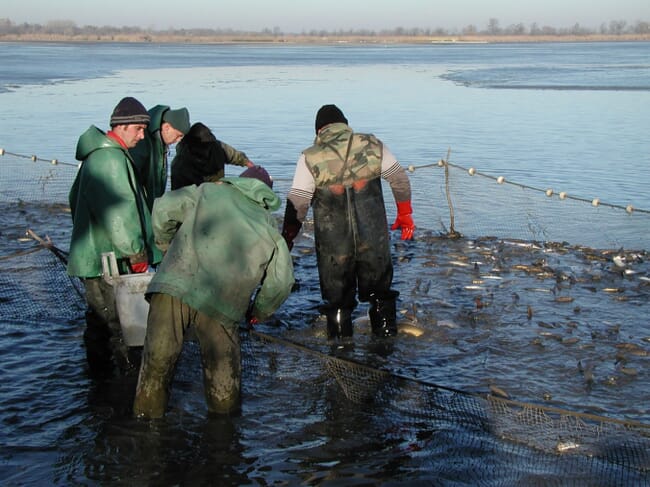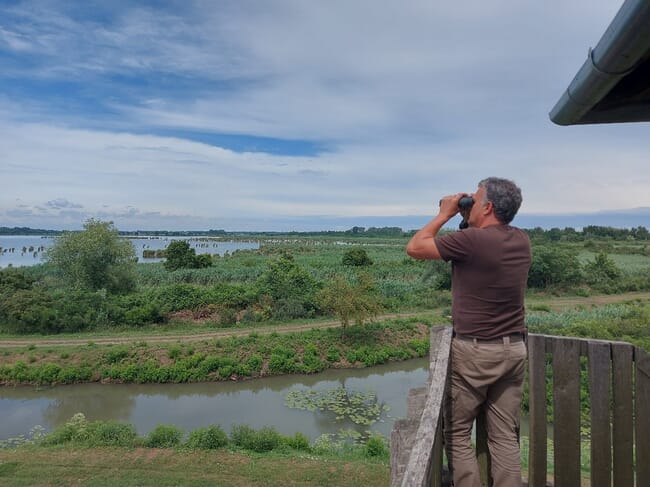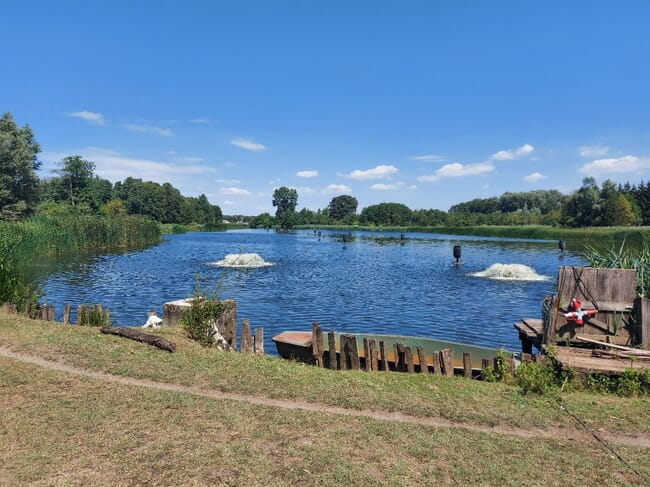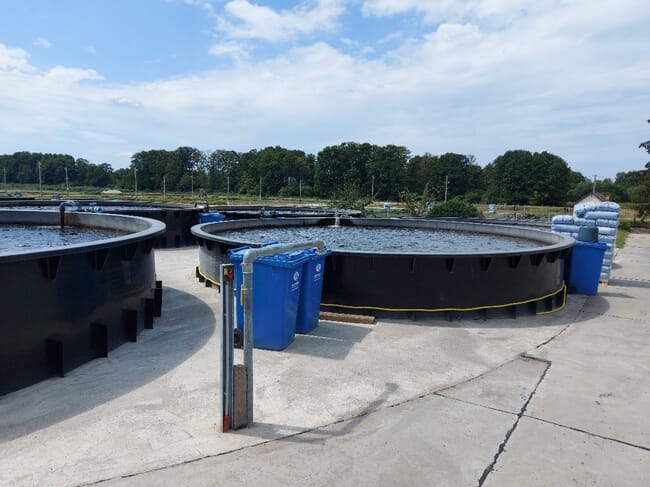
In Hungary, carp were traditionally harvested in late autumn but now a continuous harvest is needed to supply markets all year round © Győző Fent
Traditional aquaculture in ponds has many environmental benefits and can offer valuable ecosystem services. However, to keep aquaculture production environmentally friendly, while intensifying operations, some farmers are coming up with innovative solutions. We spoke to Tamás Bardócz, who has worked for the Association of Hungarian Fish Farmers, as director general for fisheries at the Hungarian Ministry of Rural Development, and currently operates as an aquaculture consultant in the country, to learn more about fish production in Hungary and his vision for the future of the sector.
Current status
Hungary, being landlocked, does not have a marine fishing fleet and prohibited commercial inland fisheries in 2016, so is solely dependent on freshwater aquaculture for their fish production. Currently, there are 377 aquaculture farms, harvesting around 19,000 tonnes of fish per year. The number one species produced is the common carp (Cyprinus carpio) followed by African catfish (Clarias gariepinus) and its hybrids. Other species cultured are bighead carp, silver carp, grass carp, pike, pike perch, rainbow trout and sturgeons.
Extensive and semi-intensive fishponds cover 26,682 hectares and account for 80 percent of the total fish production. Most farmers are micro enterprises or SMEs and typically use either barrage ponds or paddy ponds. Barrage ponds dam up a stream and collect run-off water from the surrounding area during the winter and spring. They can be found in hilly areas in the southwest. Paddy ponds are surrounded by dykes and receive water from rivers and channels. These types of ponds are more common in the lowland areas. Most farms are semi-intensive, with farmers adding fertilisers and supplementary feed to the ponds.

© Tamás Bardócz
Twenty-three companies use more intensive flow-through or recirculating aquaculture systems. While some of these farms produce rainbow trout, sturgeon, pike perch and hybrid striped bass, the majority produce African catfish – a species that Hungary produces more of than any other country in Europe. African catfish were introduced in the 1980s from the Netherlands for research purposes, but it quickly became clear that there was huge potential for production, especially due to the availability of geothermal water to grow them in. Due to its similarities with the well-known European catfish and the popularity of filleted catfish, the market for the species has doubled in the last 10 years.
Ecosystem services
The fishpond habitats in Hungary are recognised for their natural value, supporting numerous animals and plants. Over 220 bird species have been recorded at the farms, with a record of 274 species at Lake Fehér near Szeged, which is around 60 percent of the country’s total bird species. Other species living in the ponds include otters (Lutra lutra) and the European pond turtle (Emys orbicularis).
Fifty percent of all fishponds have been declared Natura 2000 sites and some are included in the list of Ramsar sites. But also the other ponds can provide services like preservation and improvement of biodiversity and landscapes, which is supported by the European Maritime and Fisheries Fund (EMFF).
According to Bardócz, extensive and semi-intensive fishponds operate as open ecological systems where natural and technological processes are in synergy and cannot be separated and can support more organisms than natural wetlands – due to factors like their increased nutrient levels, weed control and fertilisation. The main environmental benefits include provision of habitats for animals and plants, water collection and storage, and nutrient utilisation. The ecosystem services that these benefits bring include food production, water provision, waste utilisation, carbon sequestration and storage, and protection of the environment. Cultural ecosystem services at fish farms include ecotourism activities such as angling, camping, birdwatching, fish restaurants, and education.
“Hungarian fish farmers believe that their products from the ponds are the most sustainable aquaculture product,” says Bardócz. “They notice the growing population of birds and otters during the production season and if they stop using the pond it quickly turns into a marshland with a much lower diversity of birds”.

© Tamás Bardócz
That birds and otters consume fish grown in the pond is accepted by the farmers, who can receive support from the government when following stipulated measures to protect wildlife. By providing tourism and angling services in the ponds, farmers can also earn additional income. These activities also educate visitors about the environmentally friendly production of fish, but awareness campaigns are needed to provide broader understanding of the benefits that the sector provides.
Challenges
Discharge water with nutrients and suspended solids has an impact on the water quality of receiving waters during the harvest of the ponds.
“However, studies on the environmental impacts of semi-intensive carp pond farms show that during production, when effluent gates are closed, the pond ecosystem improves the reserved water quality,” Bardocz notes.
Intensive operations, although mainly using geothermal water, also have some negative environmental impacts, such as discharge of effluent water with a high nutrient concentration into the environment. In addition, escapees of invasive species can have a negative impact on wild fish biodiversity.
“Chinese herbivores (bighead carp, silver carp and grass carp) were introduced in 1963 for polyculture systems under the assumption that they cannot reproduce in the natural environment of Hungary,” explains Bardócz.
However, during recent decades there have been an increasing number of sightings of silver and bighead carp spawning in the wild. Moreover, these species can produce fertile hybrids. Fish farmers are obliged to take prevention measures to avoid escapes, such as using screens when draining ponds. In certain regions, their production is banned.

© Tamás Bardócz
Pond aquaculture is highly dependent on the environmental conditions and is thus vulnerable to the effects of climate change. In recent years, there have been longer periods of drought and more frequent floods. Farms try to adapt to these changing conditions by using aerators during the hot summer months to keep the optimal oxygen levels. Increased temperatures in winter mean the ponds are rarely covered with ice, resulting in a year-round predation by cormorants.
“Cormorants, like wolfs, hunt in flocks with specific strategies for maximum efficiency. On top of their consumption of 0.5 – 0.8 kg/bird/day, they also injure and stress at least the same number of fish, which will not eat for days and often die,” highlights Ferenc Lévai Jr, from Aranyponty Fish Farm. “We do not mind herons and otters in our ponds, but the cormorants are now one of our main problems,” he continues.
The changing climate can also have advantages however: due to the warmer winters, on some farms the carp are reaching market size (1.5 to 2 kg) in two years, instead of three.
While the demand for eating carp is decreasing, there is a stable market for restocking in angling waters.
“Marketing of carp should be improved,” argues Bardócz. “If farmers focus their marketing on the sustainability of the product and develop value-added items, carp can become more popular amongst the next generations. The latest developments in processing technology, that provide solutions to eliminate the small intermuscular bones from the fish, will most certainly help to make carp more attractive to consumers”.

© Tamás Bardócz
Looking to the future
Despite these challenges, Bardócz forecasts a promising future for Hungary’s fish farmers, especially for those who combine traditional and modern pond farming technologies.
Such a combination has been implemented by a farm in Nagyatád, where they grow African catfish in tanks, while raising common, silver and grass carp in their ponds. The discharge water from the intensive unit is first treated in a sedimentation pond, then flows to the production ponds. A Hungarian study showed that a 100 hectare pond unit can retain 100 to 250 tonnes of nitrogen and 16.5 to 40 tonnes of phosphorus during the production cycle. These nutrients are partly trapped in the sediments but also converted to fish biomass, as no supplementary feeds are added to the ponds.
As Gábor Szilágyi, farm manager, explains: “I think, using the effluents from an intensive fish farm in extensive fish ponds creates a real zero-nutrient emission system while also minimising other environmental impacts of both production units.”
In addition, many farmers have started using modern technologies – like real-time water quality monitoring and machine learning for prediction of key production parameters – in pond farms. These technologies can reduce the risks and costs of pond farming without compromising their positive environmental impacts.
“If these technological developments could be paired with a larger market for carp, we could increase production by 50 percent without adding any ponds. To achieve this, carp should be acknowledged as a highly sustainable fish product,” concludes Bardócz.




